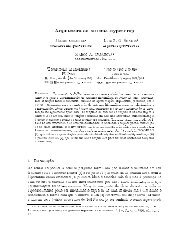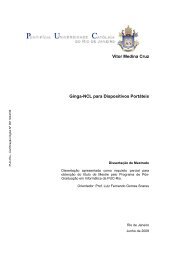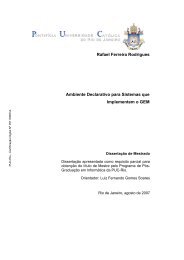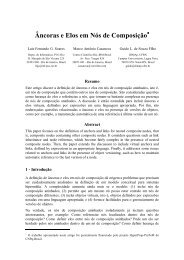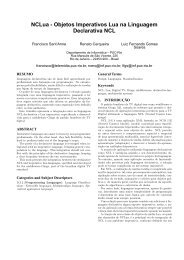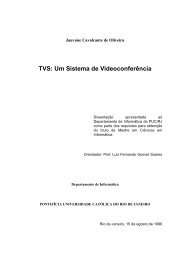Ginga-NCL: Declarative Middleware for Multimedia IPTV Services
Ginga-NCL: Declarative Middleware for Multimedia IPTV Services
Ginga-NCL: Declarative Middleware for Multimedia IPTV Services
You also want an ePaper? Increase the reach of your titles
YUMPU automatically turns print PDFs into web optimized ePapers that Google loves.
[21] L. F. G. Soares and C. S. Soares Neto, “Nested Context<br />
Language 3.0 — Reúso e Importação,” tech. rep., In<strong>for</strong>matics<br />
Dept., no. 33, 2009.<br />
[22] ITU-T Rec. H.760, “Overview of <strong>Multimedia</strong> Application<br />
Frameworks <strong>for</strong> <strong>IPTV</strong>,” Geneva, Apr. 2009.<br />
[23] ITU-R Rec. BT-1699, “Harmonization of <strong>Declarative</strong><br />
Content Format <strong>for</strong> Interactive TV Applications,” Geneva,<br />
2009.<br />
ADDITIONAL READING<br />
[1] ISO/IEC Std. 13818-6, “In<strong>for</strong>mation Technology —<br />
Generic Coding of Moving Pictures and Associated<br />
Audio In<strong>for</strong>mation — Part 6: Extensions <strong>for</strong> DSM-CC,”<br />
1998.<br />
BIOGRAPHIES<br />
LUIZ FERNANDO GOMES SOARES (lfgs@inf.puc-rio.br) is a full<br />
professor in the In<strong>for</strong>matics Department of the Pontifical<br />
Catholic University of Rio de Janeiro (PUC-Rio), Brazil,<br />
where since 1990 he has headed the TeleMídia Lab. He is a<br />
board member of the Brazilian Internet Steering Committee<br />
and Chair of the <strong>Middleware</strong> Working Group <strong>for</strong> the<br />
Brazilian Digital TV System.<br />
MARCIO FERREIRA MORENO (mfmoreno@inf.puc-rio.br)<br />
received his M.Sc. degree from the In<strong>for</strong>matics Department<br />
of PUC-Rio, Brazil, in April 2006. At present, he is a Ph.D.<br />
student at PUC-Rio and an associate researcher in the<br />
TeleMídia Lab. He has worked on the terrestrial Brazilian<br />
DTV specifications and the <strong>Ginga</strong>-<strong>NCL</strong> reference implementation.<br />
CARLOS DE SALLES SOARES NETO (csalles@inf.puc-rio.br) is an<br />
assistant professor at the Federal University of Maranhão<br />
(UFMA). He received his M.Sc. degree from the In<strong>for</strong>matics<br />
Department of PUC-Rio in August 2003. At present, he is a<br />
Ph.D. student at PUC-Rio and an associate researcher in the<br />
TeleMídia Lab. He has worked on the terrestrial Brazilian<br />
DTV specifications.<br />
MARCELO FERREIRA MORENO (moreno@inf.puc-rio.br) is an<br />
CALL FOR PAPERS<br />
NETWORK TESTING SERIES<br />
The objective of the Network Testing Series of IEEE Communications Magazine is to provide a <strong>for</strong>um across the academia and the<br />
industry to address the design and implementation defects unveiled by network testing. In the industry, testing has been a mean to<br />
evaluate the design and implementation of a system. But in the academia, a more common practice is to evaluate a design by mathematical<br />
analysis or simulation without actual implementations. A less common practice is to evaluate a design by testing a partial<br />
implementation. That is, the academia focuses more deeply on algorithmic design evaluation while the industry has broader concerns<br />
on both algorithmic design issues and system implementation issues. Often an optimized algorithmic component could not guarantee<br />
the optimal operation of the whole system when other components throttle the overall per<strong>for</strong>mance.<br />
This series thus serves as a <strong>for</strong>um to bridge the gap, where the design or implementation defects found by either community could<br />
be referred by another community. The defects could be found in various dimensions of testing. The type of testing could be functionality,<br />
per<strong>for</strong>mance, con<strong>for</strong>mance, interoperability and stability of the systems under test (SUT) in the lab or in the field. The SUT could<br />
be black-box without source code or binary code, grey-box with binary code or interface, or white-box with source code. For grey-box<br />
or white-box testing, profiling would help to identify and diagnose system bottlenecks. For black-box testing, benchmarking devices of<br />
the same class could reflect the state of the art. The SUT could range from link-layer systems such as Ethernet, WLAN, WiMAX, 3G/4G<br />
cellular, and xDSL, to mid-layer switches and routers, upper-layer systems such as VoIP, SIP signaling, multimedia, network security,<br />
and consumer devices such as handhelds. In summary, the Network Testing Series solicits articles falling in, but not limited to, the following<br />
topics:<br />
Testing functionality, per<strong>for</strong>mance, con<strong>for</strong>mance, interoperability, and stability<br />
Testing systems and services of 10G Ethernet, Power over Ethernet, WLAN, WiMAX, 3G/4G cellular, xDSL, switches, routers, IPv6,<br />
VoIP, SIP signaling, storage area networks, network security, and consumer handhelds<br />
Testing various layers of network devices including black-boxes, white-boxes, and grey-boxes<br />
Benchmarking and profiling network systems and services<br />
Network lab testing and field testing<br />
Designing network test methodologies, test tools, and test beds<br />
Evaluating false positive and negative of network security<br />
Analyzing lab-found and customer-found defects<br />
SUBMISSION<br />
Prospective authors are strongly encouraged to contact the Series Editors be<strong>for</strong>e writing and submitting an article in order to<br />
ensure that the article will be appropriate <strong>for</strong> the Series. The submitted articles should not be published elsewhere or be under review<br />
<strong>for</strong> any other conference or journal. Articles should be tutorial yet rigorous in nature. Mathematical equations should not be used<br />
(although some simple equations may be allowed if permission is granted by the Series Editor and the Editor-in-Chief). Articles should<br />
not exceed 4500 words. Figures and tables should be limited to a combined total of six. Complete guidelines <strong>for</strong> prospective authors<br />
can be found at: http://dl.comsoc.org/livepubs/ci1/info/ sub_guidelines.html.<br />
Please send PDF (preferred) or MSWORD <strong>for</strong>matted papers to Manuscript Central (http://mc.manuscriptcentral.com/ commag-ieee), register<br />
or log in, and go to the Author Center. Follow the instructions there, and select the topic "Network Testing Series." Since this is a<br />
regular series, papers can be submitted at any time <strong>for</strong> consideration <strong>for</strong> subsequent issues.<br />
SCHEDULE<br />
2~3 issues per year with submissions at any time<br />
SERIES EDITORS<br />
Ying-Dar Lin Erica Johnson Tom McBeath<br />
ydlin@cs.nctu.edu.tw erica.johnson@iol.unh.edu Tom.McBeath@spirent.com<br />
National Chiao Tung University University of New Hampshire Spirent Communications Inc., USA<br />
Network Benchmarking Lab (NCTU-NBL), Taiwan InterOperability Lab (UNH-IOL), USA<br />
IEEE Communications Magazine • June 2010 81



